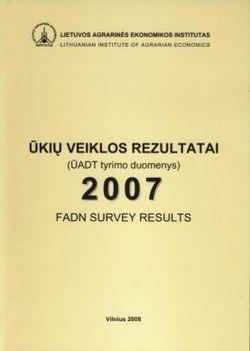
Statistical publications „FADN survey results“ are published annually since 1996. The publication of 2008 is based on accountancy data of 2007 from 1303 family farms and 48 agricultural companies. Selected farms cover all districts, natural zones and reflect different farming conditions.
Lithuania must deliver data of 1000 farms to the EU Farm Accountancy Data Network (FADN). Lithuania is considered to be one FADN region, the threshold of the field of observation is 2 ESU (European Size Units). A sample farm represents 35 - 40 farms. According to the Lithuanian legislation Lithuanian Institute of Agrarian Economics is assigned to be a Liaison Agency, Lithuanian Agricultural Advisory Service - Accountancy office.
Like in previous years, statistical results of family farms and agricultural companies are presented separately, as they are very different from both economic size and labour input. Some types of farming and economic size classes are aggregated. Weighted averages per farm are calculated for each group and whole country. Data of the previous year per country is also presented, what enables to compare farming results in the course of the last two years. Structure of population of family farms and agricultural companies is given in the tables 4 and 5, while the sample structures are revealed in the tables 6 and 7 respectively. Data of FSS 2007 served to calculate weighted averages for both types of farms. The sample almost completely covers field of observation. In general, year 2007 was much more favourable to agriculture compared to 2006.
The yields were much higher for most crops (except vegetables). Prices of agricultural products also considerable increased: cereals for 35- 60 per cent, vegetables - per 25 per cent, potatoes - 11 per cent, milk - 21 per cent.
In general, farming results in family farms were much better compared to 2006 (that year was exceptionally bad for agriculture). Subsidies for production per 1 ha UAA remained on the same level, while subsidies for investment notably went down. Due to increase of production and higher prices, average total output rose by 50 per cent. Though costs were higher, total subsidies were lower, average Family Farm Income increased by 25 per cent compared to 2006. The best results per 1 ESU were achieved in the dairy farms.
Similar improvement was noticed for Agricultural Companies as well. In 2006 average gross profit (total output minus total input) was negative and only subsidies allowed to reach positive results. In 2007 average total output increased even by 70 per cent. Costs were also considerable larger. Difference from family farms is that both subsidies for production and investment were higher compared to previous year. It resulted to huge increase in Farm Input. Generally, the best total output per 1 ha UAA and 1 ESU were achieved in mixed agricultural companies specialised in crop and granivores production. Respectively, farm income were best in the farms of horticulture and permanent crops. This publication contains 50 tables. Both family farms and agricultural companies are grouped by:
- economic size;
- type of farming;
- area;
- land quality point.
In addition family farms are grouped by:
- farmer’s age;
- counties;
- less favoured (LFA) and normal areas;
- organic farms.
Types of farming in family farms (row headings in the tables of family farms):
1. specialist cereals, oilseeds and protein crops (TF 13);
2. general field cropping (TF 14);
3. horticulture and permanent crops (TF 20, 34);
4. specialist dairying (TF 41);
5. mixed cropping (TF 60);
6. mixed livestock, mainly grazing livestock (TF 42, 43, 44, 71);
7. field crops-grazing livestock, combined (TF 81);
8. field crops and granivores, combined (TF 50, 72, 82).
Types of farming in agricultural companies (row headings in the tables of
agricultural companies):
1. crops (TF 13, 14);
2. horticulture and permanent crops (TF 20, 34);
3. field crops-granivores, combined (TF 50, 82);
4. field crops-grazing livestock, combined (TF 41, 43, 81).
© Quoting requires reference to the source and website address.
